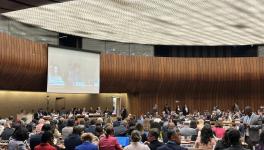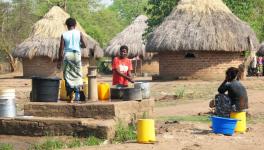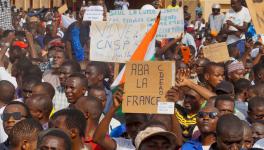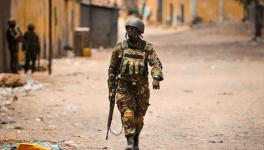Surplus Doses in US and UK can Vaccinate all of Africa
As the SARS-COV-2 virus mutates and spreads in its new avatar called Omicron, vaccine inequity is a serious threat to not just the population in the less vaccinated regions of the world but also to the vaccinated populace of the rich countries. It has been two years since the COVID-19 pandemic hit the world and about a year since the first vaccine became available. However, a large proportion of the population remains unsafe and unvaccinated. Most of this unvaccinated proportion is in the poorer countries of Africa, Asia and South America.
Figure 1 below shows this vaccine inequality across major countries and country groupings across the world. The African continent has a very small proportion of population which is fully vaccinated. There is a stark contrast in the share of fully vaccinated population between the Europe and Africa – Europe has 64% of its population fully vaccinated while Africa has only about 8%.
Only a few countries in Africa such as South Africa and Botswana have managed to fully vaccinate about 26% and 22% of their populations respectively. Other countries such as Ethiopia, Tanzania, and Kenya have a much lower proportion of fully vaccinated population -- 1.2%, 1.8%, and 6% respectively – as compared to the average for Africa (8%).
Vaccine Inequality across Major Countries and Country groupings (% of fully vaccinated population)
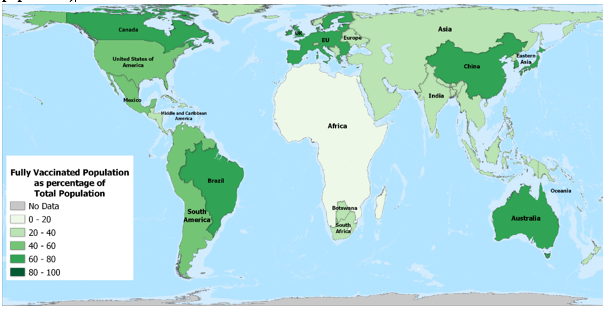
Prepared by Newsclick with data from Our World in Data
On the other hand, rich countries such as the United Kingdom, France, Sweden, and other countries in Europe have fully vaccinated about 70% of their population. Australia, Canada, and New Zealand have fully vaccinated nearly 75% of their population, and China has crossed the 80% mark; the United States has also fully vaccinated 60% of its population.
Booster Doses in Rich Countries Surpass Total Vaccination in Poor Countries
In an Interim statement (dated October 4, 2021) on booster doses for COVID-19 vaccination, the World Health Organization (WHO) and the Strategic Advisory Group of Experts (SAGE) on Immunisation and its COVID-19 Vaccines Working Group had noted that “Introducing booster doses should be firmly evidence-driven and targeted to the population groups in greatest need”. Among factors to be considered for deciding on booster doses, the experts note that in addition to factors such as waning immunity and vaccine effectiveness, the factor of global availability of vaccines and global and national equity need to be considered.
However, the rich countries have completely disregarded this advice and caution from the WHO. At a time when the poor countries are struggling to give even the first dose to their population, rich countries have started administering booster doses (additional dose after getting two doses of vaccines).
As Figure 2 shows, many of the rich countries have already provided booster doses to a proportion of their population much larger than the proportion of vaccinated population in Africa. For instance, the number of booster doses in European Union (EU) have already surpassed the total number of people vaccinated in Africa till date.
The number of booster doses in the US and the UK are also seeing a sharp increase, with US booster doses nearing the mark of people vaccinated in Africa. The rates of administering booster doses in EU, the US and the UK are faster as visible by the steep slope of the curves, while the rate of vaccination in Africa is slower as depicted by a relatively flatter curve.
Compiled from Our World in Data
In fact, the number of people who have been administered booster doses in Europe is roughly equal to the number of fully vaccinated people in Africa. By December 12, 2021, while about 10.9 crore people in Africa could get fully vaccinated (that is, two doses of vaccines), in Europe 10.7 crore people had already got booster doses.
In their Interim statement (updated on November 29, 2021) on COVID-19 vaccination for children and adolescents, the WHO experts reiterated that “Any guidance on vaccine use prioritization, including booster dose policy, cannot ignore the current, on-going profound inequities in global vaccine access. While higher-income countries expand their vaccination programmes to adolescents, children, and, in some countries, booster doses to a large proportion of their populations, many lower-income countries still lack sufficient vaccine supply to offer a primary vaccination series to their highest priority-use groups”.
Criminal Vaccine Grab by Rich Countries
This vaccine inequity is a consequence of vaccine grab by the rich countries. These countries have purchased vaccines in excess of their domestic requirements.
Data compiled by the Duke Global Health Innovation Centre shows that till November 2021, many of the rich countries had purchased doses more than required to vaccinate their entire population. As per this data, the US had procured vaccines that would be able to vaccinate 278% of its population. Similarly by November 2021, Canada, the European Union and the UK had procured vaccines which would be able to vaccinate 577%, 340%, and 323% of their respective population.
Taking the example of the US and taking only the adult population into consideration, we calculate that with the excess doses that the US has cornered, roughly about 93% of Africa’s adult population can be fully vaccinated. Below we present a very rough calculation to arrive at this number.
By November 2021, the US had procured 1,725 million doses. The adult population in the US is about 251 million. That is, it requires nearly 502 million vaccine doses to fully vaccinate its adult population. Adding a 10% wastage of vaccines, the requirement is 552 million doses of vaccines. Thus, after fully vaccinating its adult population and with a 10% vaccine wastage, the US has about 1,173 million surplus doses left from the total procured vaccine doses.
Africa, on the other hand, has about 681 million adult population. Out of this 109 million have already been fully vaccinated, leaving nearly 572 million unvaccinated. Here we are not factoring in the partially vaccinated population, the inclusion of which would further reduce the number of vaccine doses required by Africa. This 572 million adult population would require 1,144 million vaccine doses and adding a 10% wastage, the requirement would be 1,258 million doses. This is about 93% of vaccine doses that the US is left with after vaccinating its adult population.
As Figure 3 shows, Africa’s requirement to vaccinate the remaining population would be more than fulfilled if the US, the UK, and Canada share some of their surplus doses, left after fully vaccinating their respective adult population.
Surplus Doses in US, Canada and UK versus Total Doses Needed in Africa (in million)
Compiled from Our World in Data
This criminal grab of vaccines by the rich countries is one of the major factors of the stark vaccine inequity currently prevailing across the globe. Despite continuous appeals by the WHO to address the perpetuating vaccine inequity, there has been hardly any change in the situation. Will the rising threat from the Omicron variant make the rich countries wake up and ensure that the poor countries are also able to effectively vaccinate their population?
World Map showing vaccine inequity is prepared by Elora Chakraborty and Peeyush Sharma.
Get the latest reports & analysis with people's perspective on Protests, movements & deep analytical videos, discussions of the current affairs in your Telegram app. Subscribe to NewsClick's Telegram channel & get Real-Time updates on stories, as they get published on our website.











